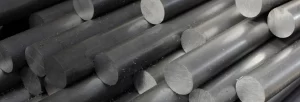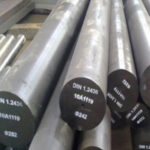Types of Tool Steel and Their Classification
Introduction
 Tool steel refers to a variety of carbon and alloy steels that are designed to make tools. The steels are specially engineered to provide qualities like hardness, wear resistance, toughness and high temperature strength required in tooling applications.
Tool steel refers to a variety of carbon and alloy steels that are designed to make tools. The steels are specially engineered to provide qualities like hardness, wear resistance, toughness and high temperature strength required in tooling applications.
There are numerous types and classifications of tool steels optimized for different tooling needs. This article will provide a comprehensive overview of the major tool steel types and classification systems used to categorize this important class of engineering materials.
What Makes Tool Steels Unique?
Tool steels derive their unique properties from their chemistry and sophisticated heat treatment. The key characteristics that set tool steels apart include:
- High carbon content – Typically 0.7-1.5% carbon to facilitate hardening through formation of martensite
- Alloying elements – Large amounts of chromium, tungsten, molybdenum, vanadium and cobalt to promote hardness and hot strength
- Quenching and tempering – Precise heat treatment sequences to develop necessary hardness and toughness
- Carbide formation – Alloy carbides provide excellent wear resistance and help maintain hardness
- High hardness – Ability to reach hardness levels up to 68 HRC for shaping and cutting other materials
- Hot hardness – Strength and hardness retained even when reaching high temperatures during use
Tool steels stand apart from other types of steel thanks to their specialized chemistry and heat treatment which imparts superior properties.
Tool Steel Classification Systems
There are several major systems used to categorize different grades of tool steel:
AISI/SAE Tool Steel Classification
The AISI/SAE system uses a letter prefix to denote alloy type followed by a 1-3 digit number indicating carbon content:
- A Series – Air hardening medium alloy cold work tool steels
- D Series – High carbon high chromium cold work tool steels
- H Series – Tungsten-molybdenum hot work tool steels
- M Series – High speed tungsten steels
- O Series – Oil hardening medium alloy tool steels
- S Series – Manganese silicon shock resisting tool steels
- T Series – Tungsten steels
- W Series – Tungsten-chromium steels
Examples: A2, D2, H13, M2, O1, S7, T1, W1
DIN Tool Steel Specification
The German DIN system utilizes a 1.23XX numbering format:
- 1.2080 to 1.2842 – Unalloyed and low alloy cold work tool steels
- 1.2311 to 1.2365 – Low alloy cold work tool steels
- 1.2367 to 1.2436 – Alloyed cold work tool steels
- 1.2714 to 1.2842 – Hot work tool steels
Examples: 1.2080, 1.2344, 1.2367, 1.2714
JIS Tool Steel Specification
The Japanese JIS system uses a 4 digit numbering system:
- SK1 to SK7 – Carbon tool steels
- SKH1 to SKH10 – Alloy tool steels
- SKD1 to SKD12 – Alloy tool steels
Examples: SK3, SKH51, SKD11
ISO Tool Steel Classification
The ISO system is an international standard that utilizes some of the AISI/SAE designations but also has unique ISO specified grades.
C, L, F Classification
Some producers classify tool steels based on carbon content and alloy level:
- C Steels – Simple low carbon tool steels
- L Steels – Low alloy tool steels
- F Steels – High alloy tool steel grades
Major Types of Tool Steels
Based on their properties and applications, tool steels can be divided into several major categories:
Cold Work Tool Steels
Cold work tool steels are designed for forming, cutting and pressing metals at room temperatures. Important alloy grades include:
- A2 – Air hardening medium alloy steel with good wear resistance
- D2 – Very high carbon high chromium steel capable of extreme hardness
- O1 – Oil hardening steel with excellent machinability and dimensional stability
- S7 – Shock resistant steel used for impact and shear applications
Hot Work Tool Steels
Hot work tool steels retain hardness and strength at elevated temperatures encountered in hot forming, die casting, forging and extrusion:
- H13 – Industry standard chromium-molybdenum hot work steel resistant to thermal fatigue
- H11 – Slightly less alloyed than H13 for better machinability
- H19 – High cobalt grade for extreme hot hardness and abrasion resistance
High Speed Tool Steels
High speed tool steels maintain hardness under the high temperatures and pressures experienced during metal cutting applications:
- M2 – The most widely used high speed steel with excellent toughness and heat resistance
- M42 – Cobalt bearing high speed steel for exceptional hot hardness and wear resistance
- T15 – Tungsten rich alloy used for cutting difficult to machine materials
Mold and Die Steels
Tool steels utilized for molding plastics and die casting:
- P20 – Low carbon steel with good machinability and polishability
- H13 – Also used for molds when extreme hardness is required
- 420 Stainless – Corrosion resistant mold steel for long life
Special Purpose Tool Steels
Unique tool steel alloys engineered for specific applications:
- D3 – Very high carbon cold work steel capable of extreme hardness
- CPM 10V – Powder metallurgy tool steel with high vanadium for abrasion resistance
- S390 – Micro-alloyed shock resisting grade with exceptional toughness
Key Tool Steel Alloying Elements
Tool steels derive their properties from strategic alloy additions. The main alloy elements include:
Carbon – Primary hardening element, typically 0.7-1.5%. Promotes martensitic microstructure. Also combines with other elements to form hard carbides.
Chromium – Added up to 5%, provides hardenability, wear resistance and some corrosion resistance.
Molybdenum – Up to 10% for increased hardenability and strength at high temperatures.
Tungsten – Crucial in high speed steels, up to 18%. Provides hot hardness and toughness.
Vanadium – Forms hard vanadium carbides, up to 4%. Improves abrasion resistance.
Manganese – In shock resisting grades up to 1.4%. Increases hardenability and toughness.
Cobalt – Added in high speed steels, up to 10%. Enhances strength at high temperatures.
Innovations in Tool Steel Manufacturing
Ongoing advances in tool steel production allow for improvements in properties, quality and performance:
- Vacuum Induction Melting (VIM) – Reduces impurities through melting in a vacuum
- Vacuum Arc Remelting (VAR) – Secondary remelting process to further remove inclusions
- Electro-Slag Remelting (ESR) – Remelting under slag to improve cleanliness
- Powder Metallurgy (PM) – Allows fine microstructural control and unique alloy compositions
- Spray Forming – Tool steel powder is spray deposited to shape and quickly quenched
- Metal Injection Molding – Binder and powder mixed, molded, then sintered to shape
- Additive Manufacturing – Complex tool steel parts can be 3D printed from metal powder
Selecting Tool Steels for Different Applications
With so many tool steel varieties available, choosing the best grade involves assessing factors like:
- Operating temperatures – Room temp, elevated temp or high temperature use?
- Required hardness – What Rockwell hardness is needed?
- Toughness requirements – Does the tool need good impact strength?
- Thermal fatigue resistance – Will the tool undergo repeated heating/cooling cycles?
- Corrosion conditions – Is corrosion likely and will that affect tool life?
- Dimensional stability – How tight are the required tolerances?
- Machinability – Will the tool require extensive machining?
Careful evaluation of operating conditions and consulting with tool steel experts helps select the optimum grade.
Heat Treating Tool Steels
The unique properties of tool steels are only realized through careful heat treatment involving:
Annealing – Soften the steel for machining by heating and slow cooling
Hardening – Heat to austenitize, then quench rapidly in oil, water, air or polymers
Tempering – Reheat to intermediate temps to reduce brittleness while maintaining hardness
Each tool steel has specific time-temperature parameters for heating, soaking, quenching and tempering tailored to its individual composition.
Applications of Tool Steels
 Thanks to their outstanding properties, tool steels are essential for all types of industrial tooling:
Thanks to their outstanding properties, tool steels are essential for all types of industrial tooling:
- Cutting tools – drills, taps, milling cutters, saw blades
- Dies and punches – blanking, piercing, forming, coining
- Gauges and measuring tools – jigs, fixtures, gauges
- Plastic molding – injection molds, compression molds
- Knives and slitting components
- Extrusion and drawing dies – rods, bars, tubes, wires
Tool steels bring hardness, strength, durability and heat resistance to virtually any tooling application across industrial and manufacturing settings.
Frequently Asked Questions
What are the major differences between carbon steels and tool steels?
Tool steels contain substantial alloying elements, especially tungsten, molybdenum, chromium, vanadium and cobalt. This provides increased hardness, toughness and high temperature strength compared to plain carbon steels.
What industries rely most heavily on tool steels?
Tool steels are found throughout manufacturing, but are especially critical in automotive, aerospace, appliances, electronics, medical devices, and consumer products.
How long does tool steel tooling typically last?
With proper selection, heat treating, and maintenance, tool steel tools and dies can last for hundreds of thousands to millions of cycles depending on the application.
What causes tool steels to be so resistant to heat?
Elements like tungsten, molybdenum and cobalt maintain hardness even at the elevated temperatures encountered during hot working, die casting, metal cutting and other tooling uses.
How are most commercial tool steels manufactured?
Tool steels are melted in electric arc furnaces or induction furnaces, refined through ladle metallurgy, cast into ingots or continuous cast into billets, then further processed into bar, plate or forgings.
What are some limitations or disadvantages of tool steels?
Tool steels can be prone to chipping due to their high hardness and low toughness. They are also challenging to machine after hardening. Cost is higher than carbon or low alloy steels.
What recent innovations have improved tool steel properties and performance?
Powder metallurgy, vacuum processing, new alloy development, additive manufacturing and advanced coatings have led to major tool steel advancements in recent decades.
I hope this comprehensive overview has provided a helpful introduction to the types, classifications, and applications of tool steels! Please let me know if you would like me to expand on any part of this article or have additional questions.

